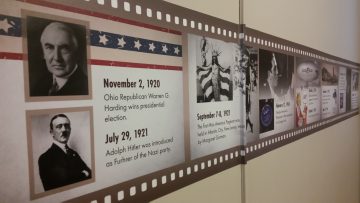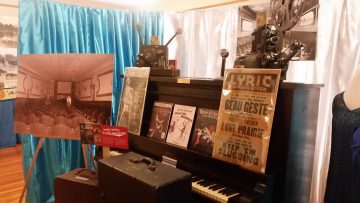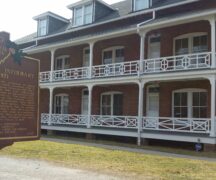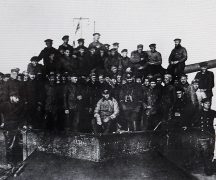By JAN LARSON McLAUGHLIN
BG Independent News
Americans were ready for a break after World War I. Unaware of the impending Great Depression and then World War II, Americans were ready for leisure when their boys came home from “the war to end all wars.”
They were ready to have some fun.
During the decade after WWI, the first Miss America Pageant was held, the Little Orphan Annie comic strip came out, Kraft created a new version of Velveeta cheese, and the first loaf of pre-sliced bread was sold as “Sliced Kleen Maid Bread.”
Life was good.
The Macy’s Thanksgiving Day parade started using giant balloons, 7-Up was invented, and George Gershwin’s Rhapsody in Blue was played at Carnegie Hall.
This era of leisure is the focus of a new exhibit opening today at the Wood County Historical Center. The exhibit celebrates the 100th anniversary of the end of WWI with “The Return to Normalcy: A Life of Leisure in Wood County, 1920 to 1939.”
The exhibit will run concurrently with the museum’s look at Wood County’s role in WWI. The WWI exhibit opened in 2017 to honor the 100th anniversary of the United States entering World War I, and both exhibits will remain on display until Dec. 1.
The new exhibit was inspired by Warren G. Harding’s 1920 presidential campaign platform “The Return to Normalcy.” Visitors are welcomed to the exhibit by a recording of Harding reading his famous speech that was credited for helping him win the presidency.
Holly Hartlerode, museum curator, is hoping visitors can relate to the images and sounds of those years. Old radios play hits from that era, like “Minnie the Moocher” by Cab Callaway, “Shim, Sham Shimmy” by the Dorsey Brothers Orchestra,” and “Red Lips, Kiss My Blues Away.”
Radios became the family entertainment center in that era, playing programs like the “Jack Benny Show,” the “Lone Ranger,” and “The Shadow” featuring Orson Welles. Those programs kept families glued to the radio listening for the next adventure.
The radio programs playing at the museum exhibit include those type of shows, plus a Wheaties cereal jingle and a baseball game between the New York Yankees and the Detroit Tigers.
“There’s no television yet, so people are still reading,” Hartlerode said. But for the first time, radios united families for home entertainment. “They brought stories into the living room. This was an event in somebody’s home.”

The museum exhibit is linked with a timeline stretching around one room, and features signs in each area reminiscent of the old red Burma Shave road signs.
Companies were offering vacations for the first time, and car payments could be spread over years. “That allows for more leisure time,” Hartlerode said.
The leisure exhibit focuses on the game of bridge, which was all the rage for a while. Americans had time to play croquet, drink beer and ride bicycles – as shown in old black and white photos – many of them taken in Wood County, Hartlerode said.
The “driving culture” also began and for the first time, people could travel on their own.
“Now that you have a car, you have the ability to go beyond where you live,” she said.
Old maps line the walls, showing the growth of the roadway systems in Ohio.
“Driving changes how people spend so much of their time,” Hartlerode said.
The early years of the “driving culture” created the “roadside picnic culture,” since few restaurants were located along roadways.
Black and white photos at the exhibit show people relaxing at the old Vollmar’s Park near Grand Rapids. Wool bathing suits hang in the displays.

Average people also started going to the theater, first to vaudeville shows, then silent movies, then “talkie” picture shows.
That, Hartlerode said, led to a change in how people dressed, with many trying to imitate Hollywood fashions – even if they had to sew the outfits themselves. The leisure exhibit gave Hartlerode an opportunity to pull out all the fashions from storage that fit the era.
“Even a real woman could look like a movie star,” some of the dress patterns advertised.
Old movie posters show promotions for “White Fang” and for “These Three,” which adds the description of “Grim! Disgraceful! What Happens to Women Accused?”
The exhibit timeline shows the crash of the Wall Street Market in 1929, leading to the Great Depression. But America seemed committed to its leisure activities. In the 1930s, highlights included Twinkies being invented, cigarette consumption jumping by 1 billion in one year, Clarence Birdseye inventing frozen food, and 30,000 miniature golf courses being in operation.
The “Buck Rogers” radio program debuted, the first drive-in movie theater was opened, Parker Brothers made the board game Monopoly, the Looney Tunes character Daffy Duck appeared in an animated feature, and the owner of the Humpty Dumpty supermarket created the first shopping cart.
In 1938, the Fair Labor Standards Act established the 40-hour work week, set 40 cents an hour as minimum wage, and prohibited most child labor. It was the same year that Adolph Hitler seized control of the German Army – which would soon lead to the end of this era of leisure.
The “leisure time” exhibit feature artifacts from the Wood County Historical Society Collection, supplemented with items and sound clips from Bowling Green State University’s Ray & Pat Browne Library for Popular Culture Studies, Music Library & Bill Schurk Sound Archives, and Center For Archival Collections.
Additional programming at the historical center will take place throughout the year to enhance the “leisure time” themes. The museum’s monthly teas and talks will cover party games from the era, popular music, the golden age of radio, the advertising and cigarette culture, the driving culture, theater during the era, the game of bridge, and popular fashions.
Visitors can interact with costumed interpreters immersed in 1920s picnic culture as part of a Demonstration Day on June 9. The Holiday Gala on Dec. 1 will also embrace the roaring 1920s.
The Wood County Historical Museum, located at 13660 County Home Road in Bowling Green, is open for self-guided tours Monday through Friday, 10 a.m. to 4 p.m., and weekends 1 to 4 p.m. Admission to the museum is $5 per adult, $1 per child age 10 and under, and free for Wood County Historical Society members. Group tours are welcome and the museum is handicap accessible. All events are detailed at www.woodcountyhistory.org





